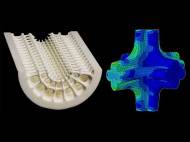Nature inspires lighter and tougher plastic components
 Certain biological materials exhibit exceptional strength due to their complex structure which has been perfected through time. Inspired by the perfected structures found in nature, researchers from the Fraunhofer Institute are collaborating on a project named Bionic Manufacturing. It aims to develop plastic products that are lightweight and strong, while being economic in their use of materials.
Certain biological materials exhibit exceptional strength due to their complex structure which has been perfected through time. Inspired by the perfected structures found in nature, researchers from the Fraunhofer Institute are collaborating on a project named Bionic Manufacturing. It aims to develop plastic products that are lightweight and strong, while being economic in their use of materials.
“We have set ourselves the challenge of working as efficiently as nature: The finished component must not weigh more than necessary and yet still be able to perform its mechanical function reliably”, said Dr. Raimund Jaeger from the Fraunhofer Institute for Mechanics of Materials (IWM). “Such components can be used to produce consumer goods with a high aesthetic value, such as designer chairs.”
In their new design method, the researchers start by constructing a virtual model of the object on the computer, filling out its contours with almost identical, cube-shaped, elementary cells. If the numerical simulation reveals that the grid structure does not satisfy requirements, the cell walls (trabecular microstructure) are refined accordingly. For instance, they can be altered to be thicker if they are too weak and thinner if they need to be more pliable, or aligned along the force lines to increase the resistance to stress caused by the load.
This method enables many different shapes to be designed around an inner cell structure that can then be evaluated and optimized by the simulation tool. To complement the simulations, the researchers carry out tests on real-life components to verify the structure’s mechanical properties. Researchers from Fraunhofer Institute for Environmental, Safety and Energy Technology (UMSICHT) are responsible for the technical implementation of the bionic design principles.
They chose to use additive manufacturing technique which involves selective laser sintering of polymer materials. Successive layers of a fine polyamide powder are laid down and fused together in the desired configuration by using a focused laser beam. It is the ideal method for creating complex internal structures and functionally graded materials – components with a distributed pattern of material properties.
Researchers report that the method has worked very well every time they have used it to design any type of workpiece based on two-dimensional templates that can be pulled into the desired shape using the computer simulation. The same applies to components with a relatively regular shape. Despite their light weight, all of these components are very strong and resilient and capable to absorb substantial shocks. If by chance one of these objects break due to excessive loading, it will collapse smoothly in localized areas rather than shattering into sharp splinters.
The method enables manufacture of products that combine a high level of mechanical stability and aesthetic appearance with low weight – for example medical orthopedic devices or anatomically formed body protectors such as lumbar support belts for skiers.









Good example of BIO MIMICKING. Yes. Plastics becoming tougher are finding many applications.
Dr.A.Jagadeesh Nellore(AP),India
E-mail: anumakonda.jagadeesh@gmail.com